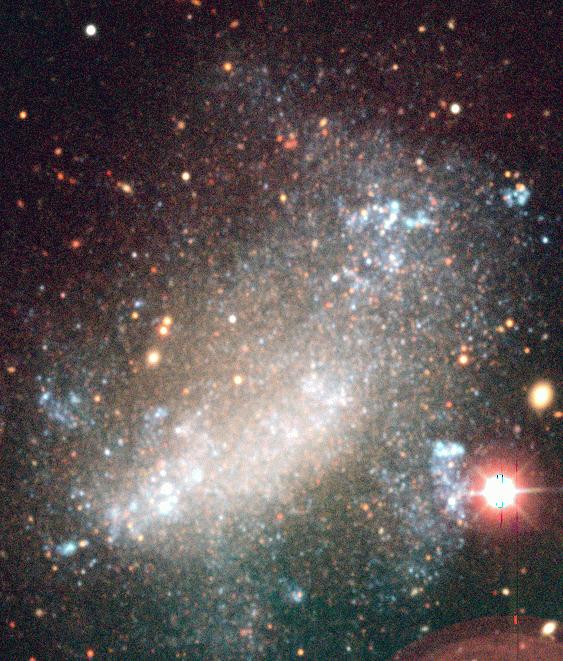

Dwarf galaxies are small galaxies whose absolute magnitude range from -16 to -19. They are small stellar systems compare to their cousins the giants spirals and elliptical galaxies. For example, the above picture show what a typical dwarf galaxy looks like. This particular one is a member of the sculptor group.
One of the most striking property of some of this dwarf is that they are undergoing a violent episode of star formation. They are therefore often called "Starburst galaxies". For example, you can see in the picture the high number of blue star indicating a high level a starf formation in this particular galaxy. Morevover, dwarf galaxies are often metal defficient compared to the solar neighborhood, with metallicity as low as one fiftieth of that of the sun. This property has lead people to think that we are witnessing one of the first, if not the very first, starburst event in this galaxies.
But optical pictures like this one are not the most powerful tools to investigate the properties of star formation. In fact, Starbursts galaxies radiate most of their energy in the far infrared, because the emission produced by the newborn blue stars is absorbed by the dust and reradiates at longer wavelengths, where the galaxy is optically thin.
I have spent six months in the Departement of Astronomy of UVA, in Charlottesville, VA, USA, working with Trinh X. Thuan on the far-infrared and radio emission of dwarf galaxies. We have studied two subsample of dwarf galaxies: The active Markarian galaxies and their quiet counterpart Low Surface Brightness (LSB) galaxies extracted from the UGC catalogue. As said previously, the far-infrared emission comes from dust heated by the young and hot stars. On the other hand, the radio emission comes mostly from electron accelerated by the supernova events. This is called the synchrotron radiation (you can find a description of the physic of synchrotron radiation here) and the emission is also optically thin in radio wavelengths for starburst galaxies.
One of the most striking property of the radio and far infrared emission is the so called "radio-FIR" correlation, which is very tigh and indicates that radio and infrared radiation are related to a single parameter, which is the star formation rate of massive stars, producer of both photons that heat the interstellar dust and supernovae that have the energy required to accelerate the electrons. I show here the radio-FIR correlation we found for the markarian galaxies who were detected at both infrared and radio wavelenghs.
The data we used for this study are gathered in 2 (big!!) tables avalaible with the following links (Postcript compressed files):